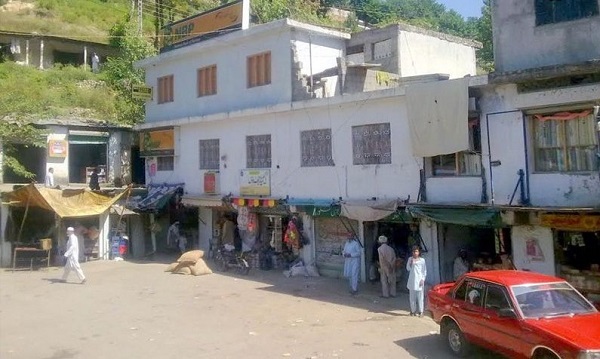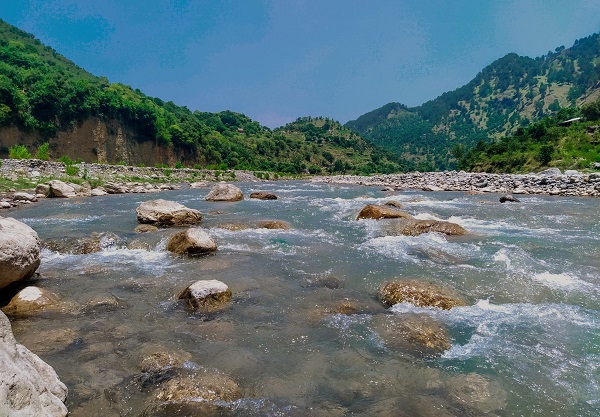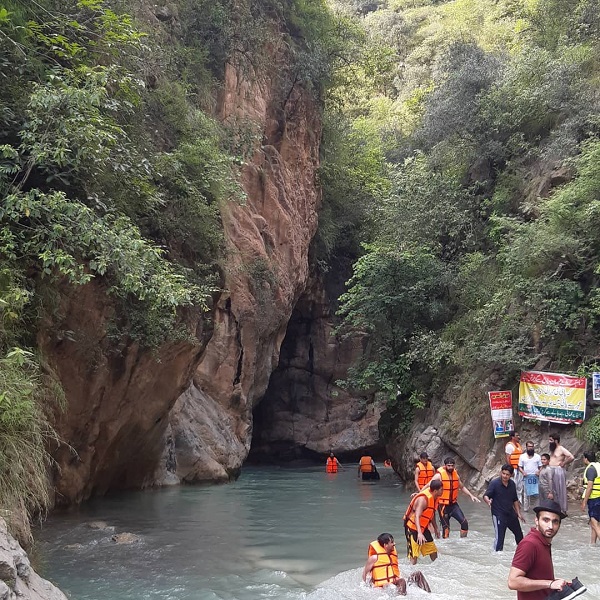
Written by: Muhammad Awais
Posted on: July 12, 2022 |  | 中文
| 中文
Noori Waterfall
As a travel writer, one is often on the lookout for interesting places to explore, and every so often one’s efforts are rewarded with a location close to home, with a largely undisturbed area of majestic scenery. Noori Waterfall is one small part of the majestic Haro river, which flows through the Abbottabad Valley and is home to Khanpur Dam. The river has a total of six waterfalls, each deeper and more difficult to wade through as the river goes upstream. Our party of four decided to take a trip, and see this place for ourselves. What we found was an unexpectedly tranquil and picturesque place, yet to be disturbed by human activity.
Using the recently constructed road over Margalla Hills, the route to Noori Waterfall from Islamabad is about 3 hours long. We started early in the morning from Islamabad, driving up to Pir Sohawa, Monal and then over the hills to Haripur. As we left the sleepy city behind, we were surrounded by thick trees, local birds and the sound of water trickling from nearby streams.
We finally reached the quaint village of Jabri, with the road leading into the main bazaar. We stopped for breakfast at a local dhaba (roadside cafe) by a shrine on the main road. Surrounded by the peace of the forest and the wonderful music of a local Sufi poet, we enjoyed an omelette with fresh tandoori roti (flatbread made in a clay oven), and piping hot chai (tea). The food was warm and delicious, and well satiated we continued on our journey.
From Jabri, one turns a sharp left to the Haro River valley, over a dirt track. Although this road also goes to Khanpur Dam, we turned after 45 minutes towards Peena village (there are signs that help visitors find their way). At the end of the road is a school and a parking spot, from where our journey began on foot and we met a local villager who volunteered to be our guide.
It takes another 20 minutes down a rough walking trail, through another valley covered with trees and bushes of different shades of green. At the end of this trail is a roofless cove that looks as though it belongs to another time and world. The astonishingly beautiful walls of rocks and boulders have tall and vibrant trees growing on each side. The floor is made up of soft, slippery sand which contrasts with the cool, blue water.
The waterfall itself is about ten feet high, and is deeper on the sides where the pool meets the cove. The pool is fed by the Koh Siri Bang peak, the third highest of Khyber Pakhtunkhwa. Life jackets are easily available at the beginning of the cove, and they cost about Rs.100 to rent. Unfortunately, however, many young men venture to swim in the pool and one hopes that in the future, the area would be more open and enjoyable for everyone who wishes to visit. It truly is a sight not worth missing, that too so close to Islamabad.
Locals are not completely sure why it’s called ‘Noori de tahand’ (Noori’s Pond), and the oral histories tell diverging stories. While some believe the waterfall is named after a now-extinct tribe named Noori, others believe that it is named after Noor Bibi, a village elder who drowned in the pool over a century ago. People from Jabri also believe that the water’s milky appearance at night led the elders to call it ‘Noori abshaar’ or the ‘Waterfall of Light’.
We tried venturing a little further to see the other waterfalls behind Noori, but that required climbing steep ledges which was too dangerous even with our combined skills. We did, however, hike to Sangam Waterfall which was 30 minutes upstream from Noori on the Haro River.
Sangam was a taller waterfall and the pond was darker too, with deep rock crevices covered in moss. The water itself is slightly bitter, but our guide informed me that the water had healing properties, particularly for one’s digestive tract. It was still as beautiful, and more peaceful because not many people were there to take in the tall trees and the fascinating birds floating over the pond. We filled up a bottle, took a few more pictures and headed back to our car.
The area has only recently caught the attention of the public, after a video in 2020 went viral on travel groups on social media. But apart from littering, safety remains the biggest issue as the depth of the lake has not been properly calculated, and there are very few protection mechanisms set in place in case of emergencies. Over the year, many young boys have unfortunately lost their lives due to drowning or collisions against large rocks. If the waterfall is to be converted into a family spot or a tourist location, stricter mechanisms for safety and surveillance will be necessary.
Noori Waterfall is a fantastic combination of Pothwari village life and natural beauty. This section is a small part of a wider region of Haripur that is home to nature as well as local history. There are many more sites to discover, and as more roadways connect big cities to larger towns like Jabri, more people can readily access these wonderful spots. And they are perhaps best enjoyed in their unspoiled pristine condition, without a large-scale tourist infrastructure that could damage the ecosystem.



You may also like: